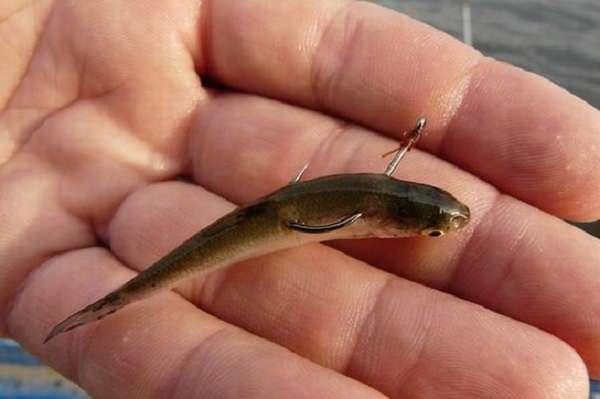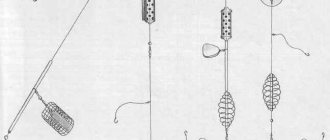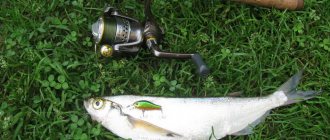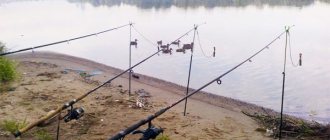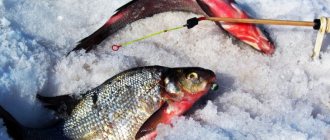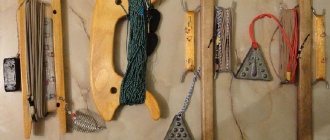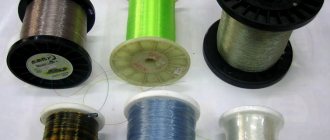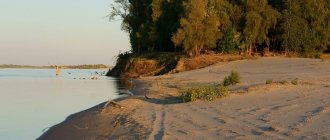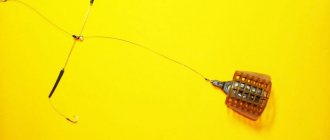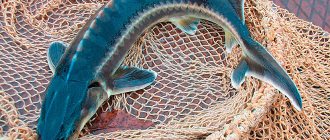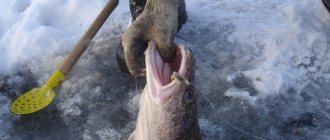On strong river currents, winter donka is almost the only possible way to catch fish from the ice. The current does not make it possible to use conventional equipment for still water, winter fishing rods or jigs for the game. Winter donka fishing is a separate large layer of ice fishing information. In this article, we will analyze the features of installation and equipment of sub-ice bottom gear for currents, and consider the nuances of tactics and fishing techniques.
Application of sub-ice donks
Winter donkey fishing rods differ from tackle for still water primarily in the weight of the overall installation. The main function of the gear in any configuration is to hold the rig at the fishing point in the current. Therefore, heavy sinkers or feeders are used in donks. A nod is used as a bite alarm - the winter float will simply be pulled under the ice by the current.
Any fish that is present in the riverbed areas in winter is caught on ice bottoms - bream, crucian carp, carp, roach, bluegill. Pike perch, bersh and burbot are used for live bait, dead fish or cut fish. There are many designs of similar winter gear. Depending on the fishing conditions and the preferences of the fisherman, you can use a variety of designs, equipment and installations. Let's figure out how to make a winter donka.
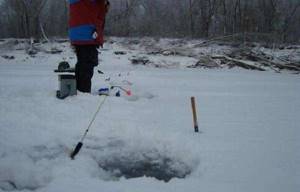
Equipment
The main thing in heavy bottoms for the current is the correct equipment. The design of the tackle itself is secondary - both ordinary winter fishing rods with reels and reels are used. The donkey rig for winter fishing provides the necessary functionality of the gear. The fishing technique actually depends on this. It is the difference in installation that determines whether winter gear belongs to one type or another.
Equipment elements
The components of equipment for winter fishing with donk are selected based on the size of the fish being hunted. The fishing line for roach is used no thicker than 0.14 mm (preferably 0.12 mm), for bream or crucian carp - up to 0.18 mm. To catch predators, diameters of 0.3-0.5 mm are used. For equipment, it is better to use special winter monofilaments with low memory or fluorocarbon, which is characterized by rigidity (leaders do not get tangled), frost resistance and invisibility in the water. In general, for catching peaceful fish in the current, thicker fishing line is used than with standard winter gear.

During the current, the fish is not so timid, it takes it boldly and efficiently. Winter fishing line about 16-0.25 mm is suitable as the main line for peaceful fish. All the same, thinner leads are installed in the installation - you can experiment with their diameter. Monofilament that is too thick is not used for the main line, otherwise, due to the high windage, the equipment will be carried away more strongly by the current. The entire caliber of such a winter mount is determined by the size of the hunted object and the strength of the current. For example, for roach for weak currents, fishing lines about 12-0.14 mm and weights up to 5 grams are suitable. Winter bream rig for current – 0.2 mm and above, weights 10 grams and more.
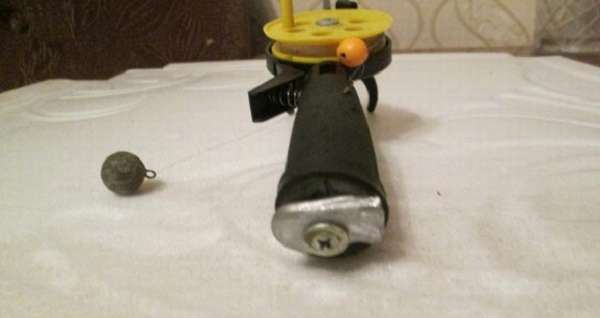
Fishing rod
As already mentioned, a fishing rod for ice fishing is a completely secondary factor. The main thing is that the fisherman feels comfortable working with the gear. Light jig balalaikas are not suitable - the bottom must stand steadily at the hole, holding the equipment, which is inflated by the loop in the current. Regular store-bought winter fishing rods with reels equipped with spring nods are used. Some anglers make homemade versions based on crossbars for a hole with a reel or reels. The design of the winter fishing rod itself can be anything. It is important that it fulfills the functions assigned to it - stable installation on ice, storage of a supply of fishing line, ease of transportation, assembly and disassembly. The main thing in winter bottom fishing rods is the equipment itself and the installation of the working part.
Nods for donks
To register a bite, fairly rigid metal or twisted spring nods are used. The guards are adjusted so that the current does not completely bend them in the working position - otherwise the bite will not be visible. Plastic (lavsan) guards can only be used on low flows - they are too soft for bottoms. Depending on the strength of the current, the nod needs to be selected. A winter guard needs to be both sensitive and delicate, but able to withstand the force of the flow.
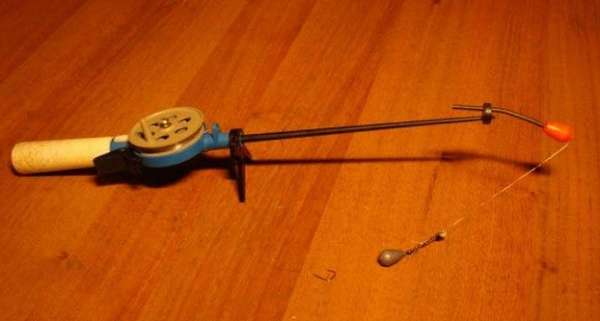
Hooks and jigs
Hooks on winter bottoms are used relatively small, size 10-20 according to the international classification - bloodworms are often used as bait. The size is selected depending on the type and size of the trophies. In any case, it is better to use trusted manufacturers (Owner, Hayabusa, Gamakatsu) and re-tie the rigs, especially after intense fishing. In some types of donks, jigs are also used, for example, to load the end of a long leash. In the depths, phosphorus accumulative and reflective jigs work well, especially when fishing at night.
Regardless of the installation, the winter equipment of the donkey should be thought out and configured. The nod, the sinker, the thickness of the fishing line - all components are interconnected. It is impossible to make one universal equipment for all cases. Bottom winter fishing on the current is by no means a passive process, as it may seem to an inexperienced viewer at first glance. This is a constant experiment with equipment, leash length, and fishing horizon. Before stationary placement on holes, fish still need to be found, especially in the vast waters of large rivers.
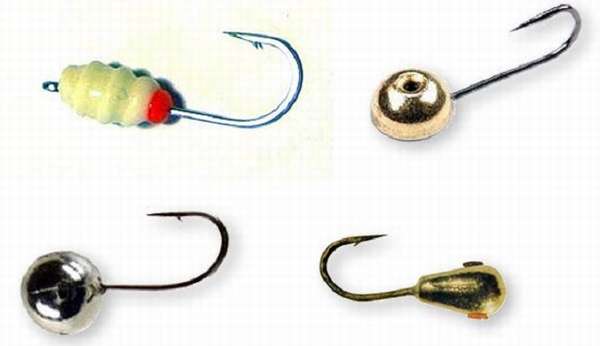
Fishing rod for donkey
As a rule, its size is up to 1 meter. However, it has now become fashionable to purchase bamboo rods up to 2 meters in length, which, in principle, is also acceptable. The fishing rod is made from wood whip; most often, juniper is used as the base material. One side of such a fishing rod is sharpened to make it easier to stick it into the ground on the shore, thereby securing the bottom. You can read the material about the secrets of equipping donkey-rubber bands.
We also recommend reading:
Gardner loop for a feeder: how to tie Feeder fishing for crucian carp Installation of gear Do-it-yourself bottom gear, production and use How to choose the right feeder for carp fishing
Winter installation options
The installation itself, in fact, determines the type of bottom winter gear. There are many types of donks, but all of them are to some extent used in versions of two types of winter rigs - retractable leashes or sliding sinkers (inline). Let's look at how to make a donkey for fishing in winter correctly.
Retractable leash
The principle of constructing a winter bottom tackle with a retractable leash is a heavy blind sinker or a feeder at the end of the fishing line. The outlet leash (or several) are located higher in the blind or sliding version. The shape and weight of the load are selected depending on the strength of the current. The stronger the stream, the heavier the sinker. The rig should be held in place, and the leads should be straightened in the direction of the current. How to install such equipment - in the article about diverter leashes in winter

Sliding sinker (inline)
In this installation, a sinker with a hole is used. The fishing line is passed through it, and the leash is knitted below. This results in a more sensitive sliding donkey equipment. When a fish bites, it pulls the line through the sinker without feeling any resistance. The same principle is used in summer feeder rigs - inline or flat method. With such a bottom you can fish not only by standing, but by pulling, lowering the tackle with a step downstream, thus fishing a large area.
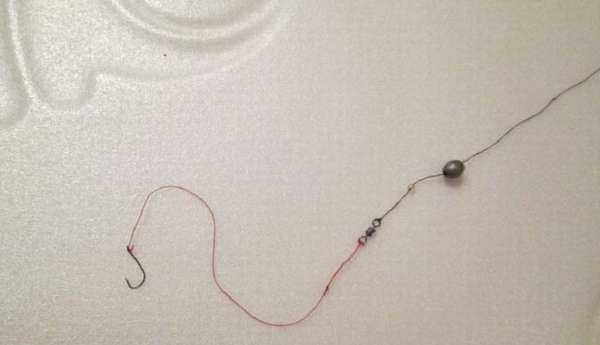
Fishing with a donk from the shore, fishing with a bottom rod (tackle)
Home » Home » Fishing with a bottom rod from the shore, fishing with a bottom rod (tackle), video
Fishing with a bottom rod (tackle)
Donka fishing from the shore
Fishing with a donk from the shore has many advantages over other fishing methods.
- firstly, they usually catch large fish with a donk
- secondly, fishing is carried out at a distance from the shore, a large part of the reservoir is fished
- thirdly, almost any fish was caught
- fourthly, low requirements and cost of gear
The most common donkey is a tackle consisting of a regular reel, a fishing line wound on it, with leads and a sinker.
The tackle is compact, lightweight and portable. But you have to throw such gear manually, which is not entirely convenient.
A more advanced option for fishing with a bottom fishing rod is to equip it with a rod and reel (for example, a spinning rod).
This option makes casting gear and landing fish much easier.
They fish with a donkey both in the current and in still water. The differences between fishing in these reservoirs are in the use of different sinkers. In the current it is flatter, in still water it is rounder.
There is also a difference in the choice of bait, depending on the body of water and the type of fish that we are going to catch.
What does bottom fishing from the shore look like?
Let's look at the gear in more detail.
- Rod. Almost any, except the lightest, for casting with dough from 50 grams and above, with a length of one and a half meters.
- The reel can also be of any kind, but preferably an inertia-free one, since it increases the casting range and has a friction adjustment, which prevents the line from breaking when landing trophy fish.
- Fishing line. It is better to use fishing line rather than cord. It clings less to bottom obstacles and is less prone to abrasion on underwater rocks. The diameter of the main line is usually used from 0.4 millimeters to 0.6. Leashes from 0.25 to 0.4 millimeters.
- Sinker. You can use both purchased and homemade ones, cast from lead in various forms. The stronger the current, the heavier the sinker.
- Various baits are used as bait: worm, crawler, lamprey larva (loach), live bait.
- Hooks are used depending on the type of bait and the intended catch of fish, but long shanks are preferable.
The sinker at the bottom is tied at the end of the main fishing line through a carabiner with a swivel (to prevent twisting) through a piece of fishing line that is slightly thinner than the main line, so as not to lose the entire tackle when hooked.
Leashes (usually 2 to 3) are tied in front of the sinker (this arrangement allows you to feel the bite more subtly). The length of the leashes is 20-40 centimeters. The distance between the leashes should be greater than twice the length of the leashes (so that they do not overlap).
Fishing takes place from the shore; you can fish with several donks at the same time.
Hooks are tied in a variety of ways, for example, loop-to-loop or “new” using triple swivels and carabiners.
Instead of one of the leashes, sometimes a feeder is tied to attract fish. Or the feeder is made heavy and used at the same time as a sinker.
Bottom fishing
A bite alarm is served by the tip of the rod, a special bell suspended on a clothespin, for example, or simply a stick with a cleft hanging on the fishing line. There are also electronic bite alarms. Both sound and light. The main thing is that all these devices do not interfere with fishing.
Donka fishing is successful throughout the day, but night fishing is especially interesting. For such a case, of course, you need to stock up on a headlamp (to keep your hands free) and a light bite indicator.
In general, bottom fishing often brings good luck. When other gear is simply powerless.
In conclusion, the video of fishing with a donk from the shore:
Latest searches:
- carp on donka on the lake from the shore
- how to fish with donka video
- fishing with bottom tackle spring 2017
- What does a donka look like?
- how to fish for donka
- signaling tip for spinning rod for bottom fishing
- Donka fishing
You will help me a lot by recommending this article on social networks!
Source: https://ribalcka.ru/lovlya-na-donku-s-berega.html
Tackle
Now let's look at winter bottom gear directly. In each of them, one of the two installation methods described above is used to one degree or another.
Truck
A standard ice bottom used by fishermen most often. It is this tackle that is most often associated with winter donka. It is a fishing rod with a reel and a nod, equipped with the installations presented above without additional nuances in its pure form. Which winter installation to use depends on the body of water. One or the other works under different conditions. Therefore, universal equipment is more often used, which includes both the inline principle (sliding sinker and lower leash) and the upper outlet. The outlet is also mounted in a sliding version through rubber stoppers - this allows the donka to work at different horizons (which is especially important when fishing for roach, blue bream, and sabrefish).

You can place several jigs (regular or phosphorus) on leashes. This way you will get a locomotive rig for winter fishing. The fisherman’s task during bottom fishing is to select the working length of the leashes and the fishing horizon. The lower leash with the hook should be located on the bottom - for fish taking at the bottom. Accordingly, the upper one is in the water column.
Depending on the strength of the current, you can use different shapes of sinkers - olives, through spoons, diamonds. It is important to securely fix the equipment on the bottom at the fishing point. But it is not recommended to use a sinker that is obviously too heavy. The weight of the equipment is adjusted relative to the flow so that in the working position the sinker is held at a point. But when biting, the fish should tear it off the bottom relatively easily. Thus, even if the angler missed, the chance of automatic hooking is higher.

Donka without a fishing rod
A common tackle is a regular hook with a reel, modified for winter conditions. The equipment is the same as in the fishing rod. It’s just that the donka is mounted not on a fishing rod, but on a platform (board) with reels. A nod is also mounted on the platform, through which the fishing line is passed. The donk with the reel is installed directly across the hole.
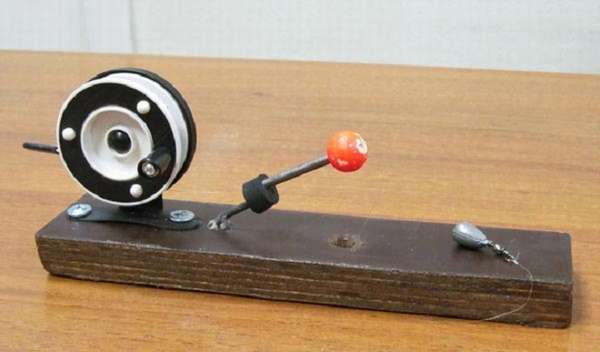
Donka wheel
The donka wheel works on the principle of a girder - to swallow, followed by unwinding the supply of fishing line. In essence, the wheel is a girder for peaceful fish, a tackle with running equipment. In a simple version - the same crossbar, only without the reels. A reel with colored stripes along the radius is mounted on a board (so that the unwinding can be seen from afar). Editing is often done online. This gear is designed for more passive fishing of large fish - carp, carp, trophy bream. You can monitor it from afar, increasing the time the angler can react to a bite. However, with active biting under normal conditions, it is better to use standard donks, which require constant observation and hooking in case the nod is bent. The wheel often slips, as the fish throws the bait when it feels the weight of the load.
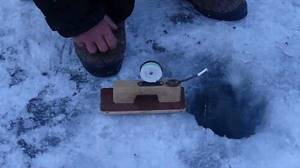
Winter feeder
This gear is not fundamentally different from a load. It’s just that this winter installation and equipment uses accessories for summer feeder fishing - feeders and a fishing rod with a spinning reel. Accordingly, fishing is carried out using the American method - with a rod, and not with a fishing line. Such winter donks are an outlet for summer feeder apologists who are looking forward to the open water season. Read more about the winter ice feeder.
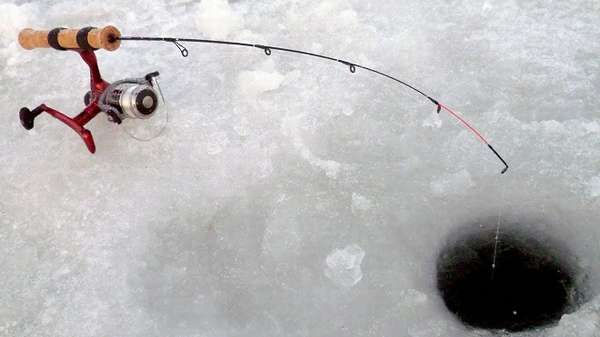
Rolling (pull-up)
This interpretation of under-ice bottom gear is used using the active method - pulling under the ice. Installation of the donkey on a pull-up - inline with a round sinker. Fishing tactics - active, with one tackle. The working part sinks to the bottom, the angler twitches the fishing rod, and the sinker rises and moves further downstream. Accordingly, in the process the fisherman slowly unwinds the tackle. The opposite is exactly the same, little by little. When retrieving, it is important to control the bottom and tension of the fishing line - otherwise you may not see the bite. The advantage of this winter fishing method is that it fishes a large area of the bottom downstream from the hole. An article about winter ice fishing.
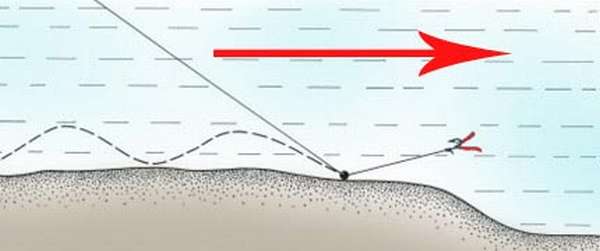
Descent
This donka is mounted according to the principle of a winter outlet leash. Only the leash used is long - up to several meters. At the end of the main line there is a feeder, which is clogged with bloodworms or jigs. The principle of operation is to wash away the feed with a jet, form a spot and place hooks with bait in this area. In the case of a descender, it is not the leash with hooks that is mounted in a sliding version on a fishing line with a load, but the feeder on the outlet.
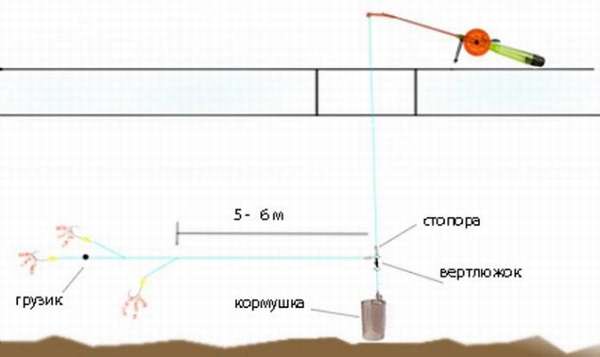
If necessary, the load moves, thereby changing the working length of the leash. This is the main point of the fishing technique - finding the working length of the leash. At the end of a long branch, leashes with hooks or jigs are tied. Spusnik is an effective bottom for winter fishing for bream and other fish in large rivers with strong channel currents (Volga, Don, Ob, Yenisei, etc.). More details - winter gear descender.
Helicopter (wing)
Winter helicopter fishing rod - development of descender equipment for strong currents and fishing in a certain horizon. A helicopter is needed when it is necessary to place several hooks with bait in a certain water horizon. This installation is needed for catching sabrefish, blue bream, and ram in the riverbed stream at half-water. But bream also takes it if you place the leash above the bottom. When installing a winter helicopter, a heavy blind sinker is used, and a long leash with hooks is equipped at the end with a special blade, with the help of which this tail is stretched horizontally in the stream and does not fall to the bottom.

Universal bottom tackle
Bottom tackle, such as a feeder, is practically universal tackle. Experienced fishermen use this type of gear to catch crucian carp, carp, bream, pike perch, roach, silver bream, perch, etc.
You can catch such fish only with a powerful, reliable spinning rod. It is better to use a feeder rod, since it is designed for such fishing conditions.
As a rule, an experienced fisherman has several types of feeders in his arsenal, designed for specific fishing conditions.
The use of certain gear is dictated by the behavior of a certain type of fish. Therefore, it is very important to choose gear for catching specific fish, for example, carp, crucian carp, bream, etc.
Winter fishing with donkeys
It makes no difference whether the subglacier uses expensive gear or winter donkeys with his own hands - the result will depend not on specific models, but on the correct tactics and fishing techniques. Each fish requires an approach. Winter conditions differ in different bodies of water. Therefore, there is no single magic recipe. The fisherman must think through a system of measures, from the strategic choice of place to the length of the leash, already during fishing. Only experimentation and visualization of what is happening under the ice is the right path to success.
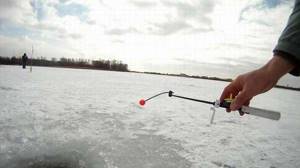
Features of winter tactics
Winter donkey fishing is not a passive activity at all. Sitting over the hole and getting fish out of it is just the last step. This, in fact, is the goal of all previous events. Tactics and techniques for bottom ice fishing include:
- Strategically correct choice of location - channel flows, entrances and exits from pits, lower edges, bottom irregularities and anomalies.
- Tactical search for points. Usually several holes are drilled perpendicular to the flow at different depths and fed (with a lump on the bottom, in a strong flow - with stationary feeders). After finding a cool place, carefully catch it and periodically feed it.
- Experimenting with winter donkey equipment during fishing - fishing horizons, changing the length of leashes, using different jigs or attachments.

You need to feed fish carefully in winter. The goal is to create a feeding spot. Therefore, bait is needed in quantities so as not to feed the fish, but only to interest them and force them to look for food in the area where the hooks with bait are located. Actually, adjusting the gear so that the hooks are located in the feeding spot, eroded by the current, is the main link in the correct technique for fishing with donks. For this purpose, the length of the leashes and their load are selected. In addition, in some rivers the current changes in strength during the course of one fishing trip. Therefore, the angler may need to change the sinker on the equipment. Therefore, it should be secured through a clasp. The specific nuances of the technique depend on the type of fish and the conditions of the reservoir.
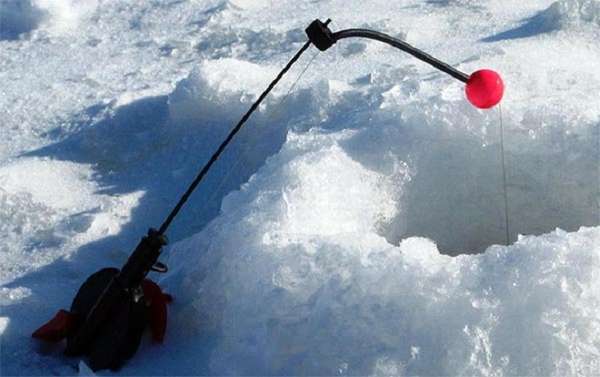
Roach
Winter bottom tackle for roach is something between a fishing rod and a donka. Frequently, the term “truck tackle” refers to just such an installation. Roach from the ice are rarely caught on the stream itself, preferring quieter areas. Therefore, heavy weights weighing tens of grams are not required. Winter donka for roach in the classic version - a sliding olive sinker and two leashes, at the top and bottom. The leashes on such winter bottom tackle for roach are usually not made long - 10-20 cm is enough. Instead of hooks, you can use plastic jigs - sometimes this improves the bite.
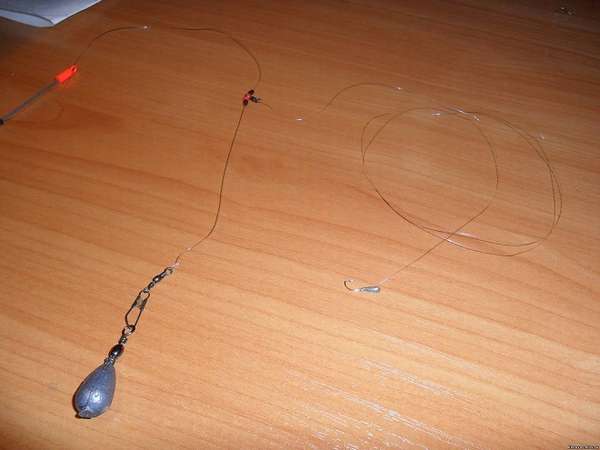
Since fishing takes place on a current of medium or weak strength, the roach load is equipped with a small olive of 4-6 grams. Therefore, both a nod and a float can be used as a signaling device. The overall caliber of gear when fishing for roach in winter with a donk is larger than for active play with a jig. The fishing line is usually used about 14-0.2 mm, and leads 0.1-0.14 mm. Therefore, with active biting, it is easier and faster to work with such tackle. The thicker line does not get tangled, and the sinker quickly delivers the equipment to the bottom. During the spring feast on large reservoirs, such gear is indispensable. An article about winter rigs for currents.
Bream
Many different equipment options are used to catch winter bream. It all depends on the fishing conditions. In weak currents it is better to use thinner half-bottoms. On the strong side - descenders, winter feeders, helicopters. When fishing for bream, the correct choice of place and feeding system are more important. The school is always on the move, and the angler’s goal is to place bait on the possible paths of movement of the bream and stop them, forcing them to look for food at the point. Learn more about catching bream from ice with donks.

crucian carp
Active fishing for winter crucian carp mostly occurs in the southern regions. In the North, crucian carp is almost never caught in winter. In the Don basin, fishing for crucian carp from ice (hybrid) is the main activity of winter road fishermen. If finely tuned fishing rods are used in still waters, then in the current - weights (like for roach). In the channel streams of the Don and its tributaries there is a whole range of donoks. If a crucian carp bites in the river, then catching it is not a problem. But the passive crucian carp also needs to be stirred up. There are no special special techniques. Often crucian carp are suitable for large portions of bait, but until this moment it can even take several hours. But then the thick-sided one stands still until the porridge is over. Therefore, one of the working methods is to attach the feeding table in advance.
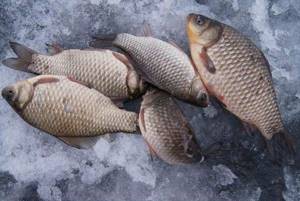
What line to use for catching crucian carp
Today there are several types of fishing threads for crucian carp:
- Monofilament is one cast nylon (polyethylene or made from other polymers) thread with high elasticity and rigidity. Under load, the thread stretches. This type of fishing line is available in any specialty store.
- Wicker. The main advantage is a high degree of strength. Braided fishing line consists of numerous thin threads that are intertwined using a special method; it practically does not stretch or deform.
- Fluorocarbon - high-tech materials are used in production. The fishing line has a low refractive index of light, it is invisible in water, has high elasticity, but does not bend or deform. But there is also a minus - it is designed for light loads.
Line diameter
When selecting a fishing line, you need to understand that the number of bites will directly depend on its thickness. For thin line you need to use light weights on the rig. In water, a thin fishing line is less noticeable to fish.
Important: the thinner the fishing line in diameter, the less windage it has in the water. This factor is important to consider in the presence of currents or strong winds.
When fishing for crucian carp, it is recommended to use a thread with a diameter of 0.1 to 0.14 mm from a reliable manufacturer. For crucian carp (since it is a sensitive fish), it is recommended to choose either braided or mono.
Line color
Crucian carp are capable of distinguishing colors, therefore, it is recommended to carefully choose the color of the fishing line. Most often, gray or brown color is chosen (if there is a large amount of silt in the reservoir). If the pond is transparent, a colorless thread is recommended.
Line stretchability
This parameter shows how much the thread can increase in size without breaking. For bottom gear, stretchability is very important, since the bite is determined directly by the rod nod, and if the stretchability indicators are high, then the moment of biting will be extremely difficult to determine.
It is important to correctly decide on the type of fishing line for catching crucian carp, let's study this issue in more detail.
Thickness and color of fishing line for crucian carp
For rods with floats, it is recommended to use braided thread with a diameter of 0.1 mm or mono with a diameter of 0.2 mm. For the donkey, it is recommended to select a braided thread with a cross-section of 0.15 mm and for a leash with a cross-section diameter of 0.1 mm, or select a monofilament main thread with a cross-section of 0.3 mm and for a leash with a cross-section of 0.2 mm.
The color in this case is also very important, since the fishing line should not scare away the fish.
Tip: for clear water, a colorless thread is recommended, for a reservoir with a green tint of water and a lot of vegetation - green, for a reservoir with muddy and dark water - brown or gray.
Monoline or braid: which is better?
Which thread to choose for fishing for crucian carp - mono or braided? It's simple. If you are using a feeder, it is better to use braid, and for float rods, monofilament would be the ideal option.
Line for catching crucian carp with a feeder
Let's take a closer look at the rules for selecting fishing line for long-casting rods. A thicker line for the feeder is recommended. If you take monofilament, then its diameter is selected from 0.18 to 0.3 mm, and if braided, then the cross-sectional diameter should be from 0.12 to 0.14 mm.
When selecting a fishing line, you need to take into account the fishing characteristics. For the longest casts, it is recommended to use braid, as the bite will be felt easier. But at distances up to fifty meters it is better to give preference to monofilament. Also, the selection of fishing line should be influenced by the reservoir itself, its latheriness and the amount of algae. The elasticity of the fishing line is selected taking into account the presence of obstacles in the reservoir.
Fishing line for catching crucian carp on a float rod
Among the features of selecting tackle for fishing rods with floats it is worth noting:
- fishing is usually done near the shore, where the fish are smaller (maximum 300 g);
- in this embodiment, the bias is placed on the float, therefore, you should not pay special attention to the stretchability of the fishing line;
- the use of monofilament is allowed;
- The cross-section of the fishing line for crucian carp fishing should be a maximum of 0.16 mm.
Monofilament line will stretch minimally, while braided line will not stretch at all. If the line is stretched too much, you may not notice the fish biting.
Monofilament and braided versions will not allow this. The diameter of the fishing line should be 0.3 mm (catch from 10 kg).
This line is not visible in the water. At long distances with a heavy feeder, it is better to use a tension cord with a diameter of 0.12 mm (fish from 5 kg are caught).
One hundred meters for spinning will be enough.
It is best to equip a spinning rod with one hundred meters of monofilament or braided fishing line. Depending on the thickness of the fishing line, visibility in the water and the weight of the prey will depend.
Donkey on a predator in winter
Winter donka fishing for predators is used mainly for catching burbot, pike perch and bersh. However, pike and perch also do not ignore live fry on a hook.
Burbot
Catching burbot with live bait or cut fish using donkeys is one of the main methods of ice fishing for this winter predator. There are no special nuances in the equipment. The main thing in catching burbot with any gear is the right place, trails or fishing spots. If there is a predator at this point, it will take it on any equipment. The installation of donks for burbot from the ice is simple, strong and reliable, the fishing lines are thick, the sinkers are heavy, and the hooks are large. You should also take care to securely install the gear on the ice so that when a predator bites it does not drag it into the hole. An article about donks for burbot in winter.
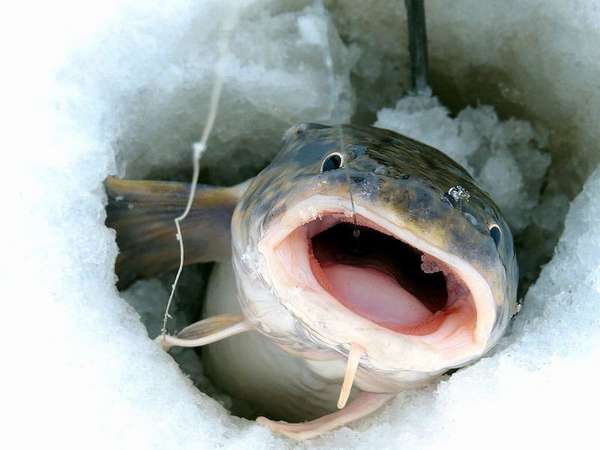
Pike perch and bersh
As you know, pike perch is a picky fish. This predator either takes it or doesn't. Exits happen at certain periods of time. Catching bersh or pike perch on donkeys in winter is one of the popular ways to catch these predators. The tackle is manufactured in various versions - both inline and retractable leash. Catching bersh on a donk in winter is no different. Shouldn't the rig be made a little lighter - the bersh is not as large and bad as the pike perch. Whole fish, slices or tails are attached to leashes, which move in the water with the current, to which the pike perch reacts. Winter donkeys for pike perch are a passive fishing method. For active fishing, it is better to use one fishing rod with a bullet and replanting a fish (sprat).
